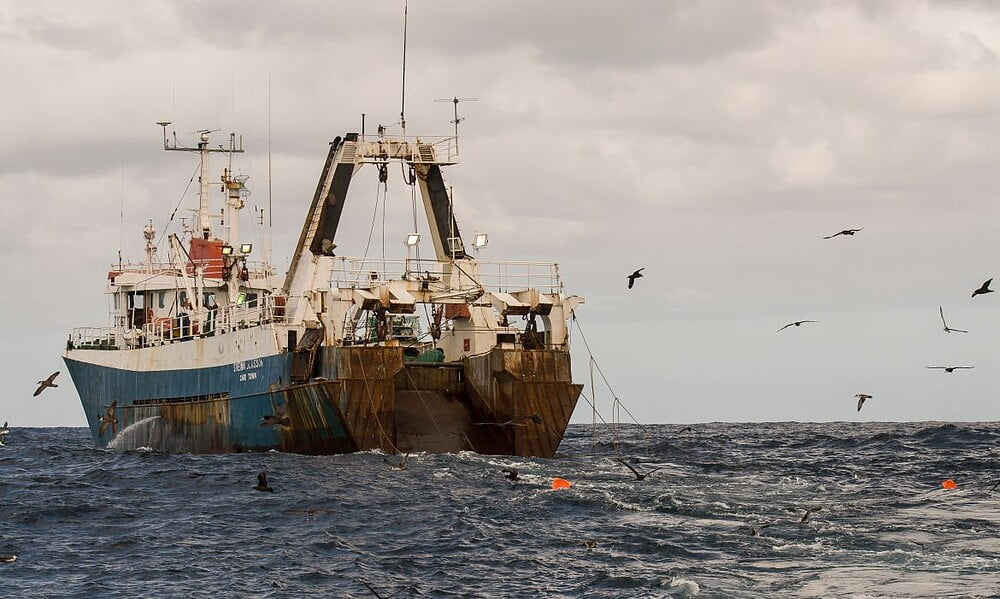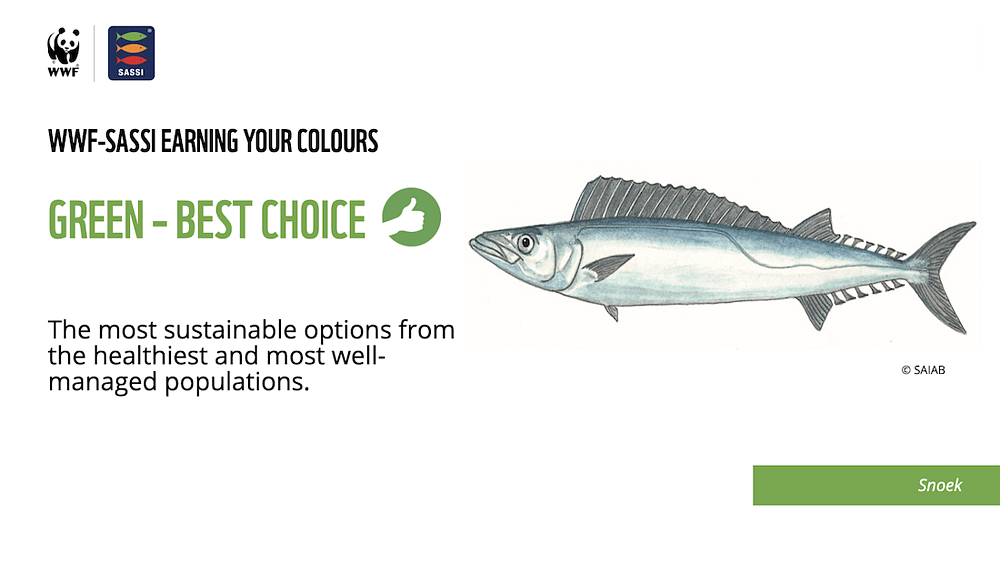If, like me, you care for our natural world, you’re often looking for more ways to make a difference for people and nature. One of the most obvious is around food and the choices we make about what we put on our plates. Enter sustainable seafood. This is a hot topic, but many of us can still be left scratching our heads, unsure how to make good food choices for the health of our ocean.
Seafood is a hit with South Africans. We consume 312 million kilograms of it each year – half of which is caught locally. And our heritage is deeply tied to the sea. Every town along our beautiful, 2800 km coastline has its own history, shaped by the tides and winds that have moulded the very shores where they lie. Connected to these histories is food – the window to local culture. To indulge in a lekker fish & chips or a bokkom braaiboodjie is a South African pastime that many can relate to or have their own version of.
Sadly, however unsustainable fishing practices and overfishing have resulted in many linefish species – the most accessible of our inshore fish stocks – being overexploited or pushed to the brink of species collapse, altering ecosystems, and jeopardising the health of our beloved sea.
1. How do different methods of fishing impact the environment?
There are numerous fishing methods, and their impacts vary greatly. Some ‘traditional’ methods which have stood the test of time, like spearfishing and rod-and-line, are thought to be less damaging because of the low catch rate and the targeted nature of the catch. Other methods, like the use of nets, enable fishers to catch larger quantities of fish and on a small scale this can be considered sustainable in some instances.
Modern fishing methods have taken these ancient techniques and industrialised them – making them bigger, but certainly not better (for the oceans at least). Industrialisation and the use of machinery allow for a more efficient system, but this ‘efficiency’ comes at a great cost to the natural marine ecosystems. What’s particularly problematic is the non-selective nature of these modern fishing methods that result in many non-target species also getting caught unintentionally. This is known as by-catch and is a major problem affecting fish stocks globally. Often these non-selective practices end up with endangered animals including turtles, dolphins, seabirds and sharks in their lines or nets, which cannot be sold or saved. This is why it is so important to question how your seafood was caught and to continuously learn more about the impact of our choices on the environment.
The various types of industrialised fishing that occur along the South African coastline include:
- Longlining involves setting a length of fishing line (kilometres in length) which floats at the surface with thousands of baited hooks along it. Using the same principle as baited fishing rods, this is designed to catch more fish.
- Gill nets are panels of net that hang vertically in the water column and act like a big underwater fence, intercepting wildlife indiscriminately as they swim past.
- Bottom trawling involves nets wider than a rugby field being dragged across the seafloor to catch bottom-dwelling species like hake and sole. These nets tear through the seafloor damaging habitats and scooping out anything that crosses their path.

2. What does sustainable seafood mean?
Sustainability is all about long-term endurance and the “renewability” of something in nature. Simply put, for practices to be sustainable they must be capable of being maintained continuously over time. For this to apply to seafood it means that a marine species must be able to breed so that the population can be replenished at a rate that doesn’t compromise its future or at a rate that allows its resilience for the future.
Unsustainable fishing practices compromise the recruitment of many species, that is the process by which very young, small fish survive to become slightly older. When they are caught too young and in too high a quantity, or by means that destroy vital habitats, this can result in population declines. Scientists have been sounding the warning alarm for decades that our effect on the ocean is unsustainable. Implementing more sustainable practices in fisheries will allow us to curb negative effects on our marine ecosystem and the associated cascading effects.
Although these practices are not perfect, there is no denying the deep pride that many South Africans have in our ocean and the accompanying desire to protect this valuable resource. Overfishing is still a problem in our waters, but understanding what pressures our fish stocks face is step one to understanding how to choose better.

3. How do I know if my seafood is sustainable?
Dr Sylvia Earl encourages us to stop thinking of fish as just a food source, and rather as natural resources that need to be protected. This mindset shift can reframe the way that we consume and can foster respect for our food and where it comes from rather than simply overindulging in it. For many, eating fish is an essential source of protein and for others, they depend on the seafood industry for their livelihood. For you, as a consumer, the best place to start is by learning to understand the sustainability status of what you’re eating or catching.
Today, consumers have the power to drive change by supporting suppliers and sellers who source sustainable seafood from well-managed fisheries. To help you make greener choices, the WWF Southern African Sustainable Seafood Initiative (WWF-SASSI) has a set of consumer -focused tools including a mobile app and pocket guide that list fish on the South African market that are best to choose or avoid based on their sustainability status, fisheries management and the fishing methods with which they are caught.
This initiative aims to shift consumers’ demands from over-exploited species to more sustainable ones. Through its tools, it provides a ‘traffic light’ quick reference guide to help you make environmentally responsible seafood choices.
WWF-SASSI is not an eco-label, nor an endorsement of specific products. The WWF-SASSI list is based on rigorous science & international best practice that ranks species according to:
- The health of fish stock and its vulnerability to fishing pressure (WHAT)
- The environmental effects of the fishing or farming method used to capture the fish (HOW)
- The effectiveness of the management of the fishery (WHERE)
The questions you therefore need to ask when it comes to seafood sustainability are: what fish is this, how was it fished or farmed and where was it caught?

4. Which fish species are considered Sustainable?
There are more than 20 species on the WWF-SASSI Green List that are considered the most sustainable seafood choices, from the healthiest and most well-managed fish populations. These can handle current fishing pressure or are farmed in a way that does not harm the ocean. So next time you decide on fish for dinner, choose one of these species and make a green choice. Some species include snoek, Cape hake, mussels, KZN oysters, Cape bream and line-caught yellowtail.
The WWF-SASSI Orange List consists of species that you may want to think twice about. These are species where there are reasons for concern either because the species is depleted because of overfishing and cannot sustain current fishing pressure, or because the fishing or farming method poses harm to the environment and/or the biology of the species making it vulnerable to high fishing pressure. Some species include Atlantic salmon, East Coast sole, red roman.

5. Are there any fish I should avoid entirely?
WWF-SASSI’s Red List of seafood species are from unsustainable populations, have extreme environmental concerns, lack appropriate fisheries management. The red list also includes specially protected species, which cannot be caught at all. The ‘No sale’ list describes species which are illegal to sell and can only be caught by recreational fishers who require a valid permit and must adhere to specific regulations. These fishers may not sell their catch and you should never buy these species. Steer clear of species such as west coast rock lobster, and silver kob.

6. Is farmed fish better than wild caught fish?
As well as a consideration of species and practice, a common question arises around the comparison between farmed and wild-caught fish. Farming is often assumed to be a suitable alternative to wild-caught fish, but although it can alleviate the overfishing problem, it comes with its own environmental concerns. Aquaculture can have detrimental effects on habitats due to pollution from the use of chemicals and excess nitrogen build-up from concentrated animal waste. Additionally, farmed fish are fed by catching smaller species in industrial fisheries – further contributing to the demand for industrial practices to continue.
Rope-grown mussels and rack-grown oysters, however, are considered sustainable. Both species are filter feeders and feed from the surrounding water, requiring no added food. Therefore, there are none of the environmental concerns associated with using processed fish as feed for the farms.
Unfortunately, the answer to the question around aquaculture is not a simple one. Some farms follow stricter rules while others still have much to learn, the WWF-SASSI list includes farmed species making it easy for you to know which farmed species are from sustainable farms. You can also look out for products with the ASC logo which means this product is from a farm that is aquaculture certified.

So, what can you do?
When all is said and done, your choices have an impact, no matter how small. By questioning your local restaurant’s or fish monger’s seafood sustainability you may encourage them to make better choices when supplying their fridges. Support small-scale fishers and ask the right questions so that you can learn if your food choices are good ones. Eating seafood can be sustainable when informed by science, and the WWF-SASSI guides make it easier for you to know how best to choose green when you’re cooking or ordering seafood for dinner.